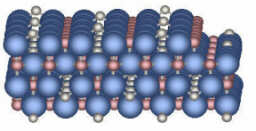 The atomic structure along step edges on metal oxide surfaces is crucial for the growth of overlayers in complex oxide devices. No experimental techniques are yet capable of resolving that structure. Ab initio calculations of step structures on metal oxides are complex and have not been reported to date.
The atomic structure along step edges on metal oxide surfaces is crucial for the growth of overlayers in complex oxide devices. No experimental techniques are yet capable of resolving that structure. Ab initio calculations of step structures on metal oxides are complex and have not been reported to date.
By taking into account both the ionic and covalent components of interatomic bonding in metal oxides, we have developed a method of predicting the relative stability of different step structures. Fe3O4 (magnetite) is a ferrimagnetic metal that is of interest for spintronics applications and as a substrate for growing complex oxides. STM observations on Fe3O4 (100) surfaces show alternating smooth and jagged step structures. By evaluating the coordinative unsaturation of step-edge ions and the excess charge along a step, we find that steps having the smallest excess charge will be most stable. The most probable arrangement of cations and anions along the step edges can be predicted.
 |
 |
| Stable step structure (a-type) | Unstable step structure (b-type) |
